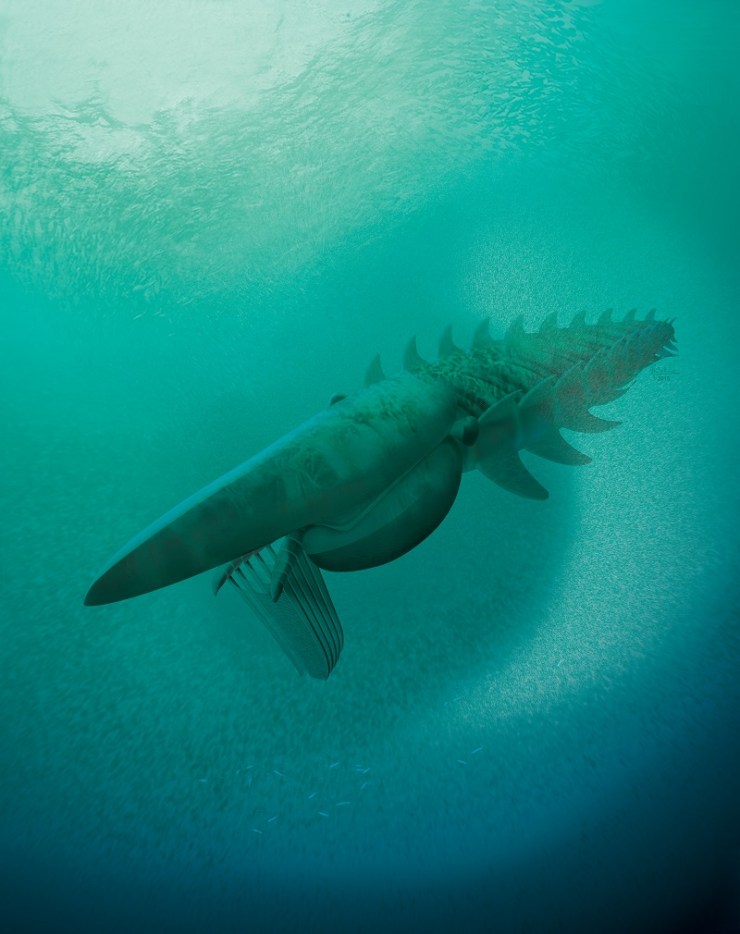 Meet Aegirocassis benmoulae – a 480 million year old, two-metre sea monster. This unlikely looking creature has been described, and imagined in this illustration, thanks to the work of one of the Museum’s research fellows, Dr Allison Daley.
Meet Aegirocassis benmoulae – a 480 million year old, two-metre sea monster. This unlikely looking creature has been described, and imagined in this illustration, thanks to the work of one of the Museum’s research fellows, Dr Allison Daley.
Through collaboration with Dr Peter Van Roy and Professor Derek Briggs at Yale University, Allie has published a paper on Aegirocassis that is published in Nature this week. Here, Allie tells us a little bit more about it…
*
In December 2012, I met Peter Van Roy at the Palaeontological Association annual general meeting in Dublin. He told me about a new specimen that had just been unearthed in Morocco, and I almost couldn’t believe what I was hearing. Peter was working with professional fossil hunter Mohamed Ben Moula, discovering ancient Cambrian-type animal communities in the much younger rocks of the Ordovician period. What you can see above is a recreation of one of their finds, which was spectacularly preserved in three dimensions. Peter invited me to join him in studying this material, and I accepted with great excitement.

Aegirocassis benmoulae belongs to a group of long extinct sea-dwelling animals called anomalocaridids. These were fearsome looking things: segmented bodies with wide swim flaps, a head bearing large eyes, a circular jaw with sharp teeth, and a pair of large claws. Anomalocaridids first appear in the fossil record during the Cambrian Explosion, a major evolutionary event that saw the rise of all animal life in a relatively rapid period of time.
They were early ancestors of the arthropods, the animal group that today includes spiders, insects, centipedes and lobsters. When they first evolved, in the Cambrian, anomalocaridids were apex predators and the biggest animals around, reaching up to about 50cm in size, but Aegirocassis benmoulae is a very different breed indeed.

Most Cambrian anomalocaridids have one set of triangular swim flaps sticking out the side of the body, but the new Ordovician animal, Aegirocassis, shows us that the anomalocaridids actually had two pairs of body flaps. These two flaps correspond to the two branches of a limb that is characteristic of crustacea and represents an evolutionary stage before the two branches had fused. In other words, It allows us to trace the evolution of one of the key body features that made arthropods such a successful group of animals right through to the present day.

As if that wasn’t enough, Aegirocassis also had a very different ecology from most anomalocaridids. While the Cambrian forms were mostly apex predators, this animal was a filter feeder – it used fine comb-like spines on its head appendages to filter plankton from the sea water. Only one Cambrian anomalocaridid also used filter feeding, but it remained a relatively modest size, while Aegirocassis was one of the largest arthropods ever to have existed.
This combination of gigantic size and filter feeding evolved from a previously predatory animal group is similar to the type of evolution seen later in whales. It makes Aegirocassis a very important animal for understanding both ecology and evolution in the oceans 480 million years ago.

Allison Daley – Research fellow You can also listen to an Oxford Sparks podcast with Allie, where she talks about the Cambrian Explosion, in the player here.



Published by